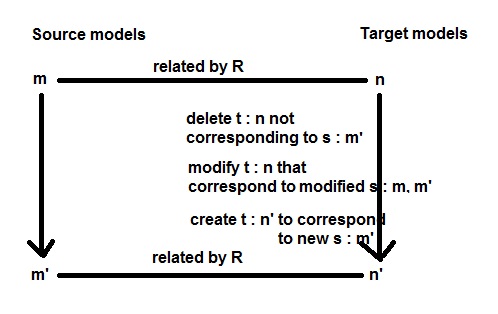Cleanup Before Construct
This is a bx pattern which
has been identified in
several bx examples.
Summary
The pattern defines a two-phase
approach in both forward and reverse
transformations associated with a bx
with relation R: the forward
transformation R-> first
removes all elements from the
target model n which
fail to satisfy R for any element of the
source m,
and then modifies or
constructs elements of n to
satisfy R with respect to m. The
reverse transformation R<-
operates on m in the same manner.
Application Conditions
A transformation tau should operate
on source m and target models n to
establish a relation R between them,
by modifying n. Changes to m need to
be propagated to changes to n.
Solution
Apply a cleanup transformation tauX
to: (i) remove elements of n that do not
correspond to elements of m; (ii) modify where necessary elements of n that
correspond to elements of m, to re-establish R between them. The
original transformation tau is then
applied incrementally to (iii) create
new elements of n where necessary
to establish R.

Benefits:
The pattern is an
effective way to ensure the
correctness of separate-models bx: all target elements which invalidate R are
removed or modified to enforce R.
Disadvantages:
There may be efficiency
problems because for each target model
element, a search through the
source model for possibly
corresponding
source element(s) may be needed. Elements
may be deleted in the Cleanup phase
only to be reconstructed in the Construct
phase: use of
Auxilliary Correspondence Model is a
means to avoid this
problem, by enforcing that feature values
should change in response to a
feature value change in a
corresponding element,
rather than deletion and recreation
of elements.
Related Patterns:
This pattern is a variant
of the Construction and Cleanup
pattern. It can use Auxiliary
Correspondence Model.
Examples:
An example is the Composers bx (bx repository). Implicit
deletion in QVT operates in a similar
manner, but can only modify models
(domains) marked
as enforced.
In UML-RSDS,
explicit cleanup rules CnX
can be deduced
from the construction rules Cn,
for mapping
transformations
(UML-RSDS Manual).

